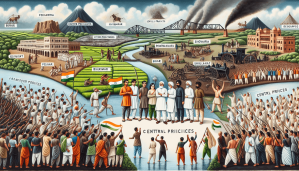
This blog explores the key events and significance of the Second and Third Anglo-Maratha Wars, as well as the pivotal Treaty of Bassein in 1802. Through an in-depth analysis of this critical period in Indian history, we will uncover how the expanding British presence in the subcontinent ultimately led to the decline of Maratha power and the consolidation of British rule.
Table of Contents
- 📜 The Treaty of Bassein (1802)
- 📜 The Second Anglo-Maratha War (1803-1805)
- 📜 The Rise and Fall of the Maratha Confederacy
- 📜 The Pindaris and their Role in the Maratha Wars
- 📜 The Third Anglo-Maratha War (1817-1819)
- FAQ
📜 The Treaty of Bassein (1802)
The Treaty of Bassein, signed in 1802, was a pivotal agreement between the British East India Company and the Peshwa Baji Rao II of the Maratha Empire. This treaty marked a significant shift in power dynamics in India and had far-reaching consequences for the Maratha Empire and British rule in the subcontinent.
Key Provisions of the Treaty
- Under the treaty, the Peshwa agreed to maintain a subsidiary force provided by the British, which effectively meant that the Marathas had to cede control over their defense and foreign affairs to the British.
- It also granted the British the right to station troops in Pune, the Maratha Empire’s capital, further solidifying British influence in the region.
- Additionally, the treaty compelled the Peshwa to accept British arbitration in any disputes with other Indian rulers, diminishing the autonomy of the Maratha Empire.
Significance of the Treaty
The Treaty of Bassein marked a turning point in the power struggle between the Marathas and the British. By effectively making the Marathas a subordinate ally of the British, the treaty allowed the East India Company to exert significant control over the affairs of the Maratha Empire, thereby paving the way for the eventual consolidation of British power in India.
📜 The Second Anglo-Maratha War (1803-1805)
The Second Anglo-Maratha War, spanning from 1803 to 1805, was a significant conflict between the Maratha Empire and the British East India Company. This war marked a crucial phase in the power struggle between the two forces, ultimately shaping the future of Indian subcontinent.
Causes of the War
The war was triggered by growing tensions between the Marathas and the British, stemming from the Treaty of Bassein and the increasing British influence in Indian politics. The British sought to expand their territorial control and diminish the autonomy of the Maratha Empire, leading to heightened hostilities and eventual military confrontation.
Key Battles and Events
- Battle of Assaye: Fought in 1803, this battle was a significant victory for the British forces led by Arthur Wellesley, later known as the Duke of Wellington, against the Marathas under the command of Daulat Rao Scindia and the Raja of Berar. The British success in this battle bolstered their position in the region.
- Siege of Bharatpur: The British forces, under the leadership of General Lake, laid siege to the formidable fortress of Bharatpur in 1805. Despite facing fierce resistance from the Marathas, the British ultimately emerged victorious, further weakening Maratha resistance.
Outcome and Impact
The Second Anglo-Maratha War resulted in the signing of the Treaty of Rajghat in 1805, which significantly reduced the power and influence of the Maratha Empire. The defeat of the Marathas paved the way for greater British dominance in India and further eroded the sovereignty of indigenous rulers, marking a pivotal moment in the consolidation of British control over the subcontinent.
📜 The Rise and Fall of the Maratha Confederacy
The Maratha Confederacy, once a formidable force, experienced a dramatic shift in its fortunes, leading to its eventual decline. The rise and fall of the Maratha Empire is a compelling saga of power struggles, military conflicts, and shifting alliances that reshaped the course of Indian history.
The Maratha Confederacy’s Ascendancy
The Marathas, under the leadership of influential figures such as Shivaji and the Peshwas, emerged as a dominant force in the Indian subcontinent. Their military prowess, strategic alliances, and administrative acumen allowed them to establish a significant presence and influence across the region.
Challenges and Internal Strife
- Internal power struggles and conflicts within the Maratha leadership weakened the unity and stability of the confederacy, leading to internal strife and fragmentation.
- The emergence of internal factions and rivalries eroded the cohesive strength of the Maratha Empire, creating vulnerabilities that were exploited by external powers.
The Impact of External Forces
The expanding presence of the British East India Company and the growing influence of European powers in India posed significant challenges to the autonomy and sovereignty of the Maratha Confederacy. The encroachment of external forces gradually eroded the power and influence of the Marathas, altering the dynamics of the Indian political landscape.
📜 The Pindaris and their Role in the Maratha Wars
The Pindaris, led by prominent figures like Aamir Khan and Karim Khan, played a significant role in the conflicts between the Marathas and the British East India Company. Their actions and alliances had a substantial impact on the dynamics of the Maratha Wars and the broader power struggle in the Indian subcontinent.
Impact of the Pindaris
The Pindaris’ incursions and attacks disrupted the stability of the region, posing a formidable challenge to both the Marathas and the British. Their tactics and strategies influenced the course of the conflicts, shaping the outcomes of key battles and negotiations.
Maratha Response to the Pindaris
- Some Maratha leaders sought to leverage the Pindaris’ actions to their advantage, utilizing their activities as a means to counter the influence of the British East India Company.
- However, the Pindaris’ actions also sparked internal divisions within the Maratha leadership, leading to divergent approaches in dealing with the Pindari threat.
Consequences of Pindari Involvement
The involvement of the Pindaris in the Maratha Wars added a layer of complexity to the already intricate power dynamics, contributing to the shifting alliances and strategies employed by the Marathas and the British in their quest for dominance in the subcontinent.
📜 The Third Anglo-Maratha War (1817-1819)
The Third Anglo-Maratha War, spanning from 1817 to 1819, marked a pivotal phase in the power struggle between the Maratha Empire and the British East India Company. This conflict reshaped the political landscape of the Indian subcontinent, leading to significant repercussions for the Marathas and the consolidation of British control.
Causes and Catalysts
The deteriorating political and administrative conditions within the Maratha Empire, coupled with the demise of key leaders such as Yashwantrao Holkar, created vulnerabilities that were exploited by external forces. The emergence of internal divisions and the weakening of Maratha strength set the stage for heightened tensions and eventual military confrontation.
Key Battles and Engagements
- Battle of Koregaon: Fought in 1818, this significant engagement witnessed the valiant defense of a British contingent against Maratha forces, symbolizing the resilience and determination of the British East India Company in the face of Maratha resistance.
- Siege of Shaniwar Wada: The eventual capture of the historic Shaniwar Wada fortress in Pune by the British marked a decisive moment in the war, signaling the waning influence and power of the Maratha Empire.
Outcome and Impact
The Third Anglo-Maratha War culminated in the defeat of the Marathas and the subsequent signing of the Treaty of Poona, Treaty of Gwalior with Sindhia, and Treaty of Mandasor with Holkar. These treaties effectively dismantled the remnants of Maratha power and solidified British dominance in the Indian subcontinent, heralding a new era of colonial rule and significantly altering the course of Indian history.
FAQ
Here are some frequently asked questions about the Second and Third Anglo-Maratha Wars and the Treaty of Bassein:
What were the key provisions of the Treaty of Bassein?
- It required the Marathas to maintain a subsidiary force provided by the British.
- The treaty granted the British the right to station troops in Pune, the Maratha Empire’s capital.
- It compelled the Peshwa to accept British arbitration in disputes with other Indian rulers.
What was the significance of the Treaty of Bassein?
The treaty marked a turning point in the power struggle between the Marathas and the British, allowing the East India Company to exert significant control over the Maratha Empire.
What were the causes of the Second Anglo-Maratha War?
The war was triggered by growing tensions between the Marathas and the British, stemming from the Treaty of Bassein and the increasing British influence in Indian politics.
What were the key battles and events of the Second Anglo-Maratha War?
- Battle of Assaye: A significant victory for the British forces led by Arthur Wellesley against the Marathas.
- Siege of Bharatpur: The British forces, under the leadership of General Lake, laid siege to the fortress of Bharatpur.
What were the outcomes of the Third Anglo-Maratha War?
The war culminated in the defeat of the Marathas and the signing of treaties that effectively dismantled the remnants of Maratha power and solidified British dominance in the Indian subcontinent.








